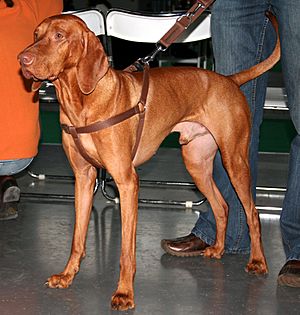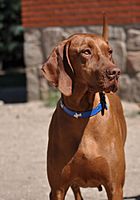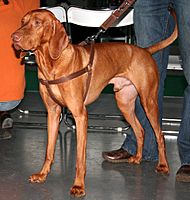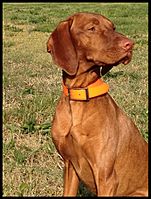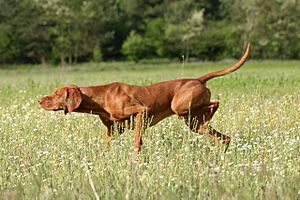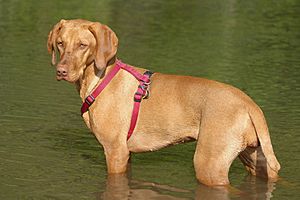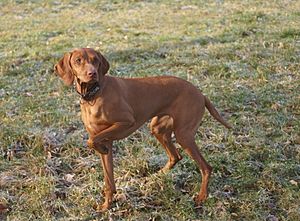Hungarian Vizsla facts for kids
The Hungarian Vizsla is a special type of dog breed. These dogs are known for being very loving and friendly, not aggressive at all. They come from Hungary and are amazing hunting dogs.
A Look Back: Vizsla History
How the Vizsla Breed Started
The Vizsla dog breed began with dogs used by ancient Hungarian tribes. Important people in Hungary, like nobles, owned Vizslas. They used these dogs to help them hunt animals such as deer, wild boar, and even wolves.
Vizslas During World Wars
The Vizsla breed almost disappeared during the First World War and Second World War. These were big wars that affected many parts of the world. During the Second World War, some Vizsla dogs were secretly taken out of Hungary. These dogs then helped to restart the breed in other countries.
All About the Vizsla: Description
What a Vizsla Looks Like
The Vizsla is a medium-sized hunting dog with short fur. They look very distinguished and graceful. They are strong but also lightly built. Vizslas are lean dogs with clear muscles. They share some looks with the Weimaraner dog breed.
Common Mix-Ups: Other Breeds
People sometimes confuse Vizslas with other dog breeds. Some breeds often mistaken for Vizslas include Redbone Coonhounds, Weimaraners, and Rhodesian Ridgebacks. The Vizsla's body shape is similar to a Weimaraner or a Redbone Coonhound. However, Vizslas are usually leaner and have more defined muscles. Weimaraners and Rhodesian Ridgebacks are also bigger than Vizslas.
A true Vizsla's nose will always be a reddish color that matches its fur. If a dog has a black, brown, or pink nose, it's likely not a purebred Vizsla. A Vizsla's eye and nail color should also match its coat.
Vizsla Colors and Coats
The most common Vizsla coat color is a solid golden-rust. This color can have different shades. Some breeding programs have dogs with a solid rust coat. You might also describe their fur as copper/brown, russet gold, or dark sandy gold.
Very dark mahogany red or pale yellow colors are not considered correct for the breed. Small white patches on the chest, neck, or tail are allowed but not preferred. It's normal for a Vizsla's coat to have slight color changes along its back.
The American Kennel Club (AKC) says a Vizsla's coat should be short, smooth, and thick. It should lie close to the body and not have a woolly undercoat. Because they don't have an undercoat, Vizslas should not be kept outside in cold weather. They are also very clean dogs and rarely need baths. They have very little "dog smell" that humans can notice. After swimming, they might have a faint wet dog smell, but a quick bath will make it disappear.
Vizsla Size
The Vizsla is a medium-sized dog. Here are their average heights and weights:
- Males
- Height: 22–25 in (56–64 cm)
- Weight: 45–66 lb (20–30 kg)
- Females
- Height: 21–24 in (53–61 cm)
- Weight: 40–55 lb (18–25 kg)
- Vizsla appearance
The Vizsla Tail
In America, the breed standard says a Vizsla's tail should be docked (shortened) to about two-thirds of its original length. However, in countries like the UK, where docking is not allowed, this is not required. A Vizsla holds its tail straight out, level with the ground. They wag it strongly when running through bushes and thick plants.
A Vizsla's docked tail is still longer than the tails of other dogs that are often docked. These include breeds like the Weimaraner, Doberman, Boxer, and Australian Shepherd. Since the tail is docked when the puppy is very young (less than three days old), the length can vary slightly between different Vizsla puppies.
Vizsla Personality: Temperament
Vizslas are very energetic, gentle, loyal, caring, and super affectionate dogs. They quickly become very close with their owners, children, and even new people. People often call them "velcro" dogs because they love to stick close to their humans.
Vizslas might cry or whine if they feel ignored or unhappy. Some will bark at strangers if they feel their "pack" (family) space is being invaded. They can be good guard dogs if they are trained well.
Vizslas are natural hunters and learn very quickly. They are excellent at both pointing (showing where game is) and retrieving (bringing back what was hunted). They will retrieve things on land and in water, using their natural skills. However, you must train them gently. They are sensitive dogs and can be easily upset if training is too harsh. Owners need to be calm but firm during training, or the dog might try to take charge!
Vizslas are great swimmers. Some might need a little encouragement to get into the water at first, but once they are used to it, they usually love it. Like all hunting dogs, Vizslas need a lot of exercise to stay healthy and happy.
Vizslas love attention, exercise, and playing with their owners. They are smart dogs and need lots of interesting things to do when they are young. If left alone for too long, they can get bored and might chew on things or dig. With good training and meeting new people and places (socialization), Vizslas are very gentle dogs. They can be wonderful around children. A Vizsla always wants to be as close to its owner as possible.
Vizsla Exercise Needs
Vizslas need daily physical activity and mental challenges. They are very active when they are outside. Indoors, however, Vizslas can be quite calm. They often prefer to rest right next to their owners. Some Vizslas can be very demanding of attention. If Vizslas do not get enough exercise, they will become bored. When bored, they might try to entertain themselves by digging or chewing on things around the house.
Images for kids
See also
 In Spanish: Vizsla para niños
In Spanish: Vizsla para niños


